Exploring the Blue Whale: The Largest Animal Ever
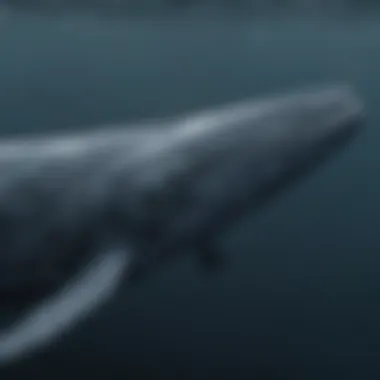
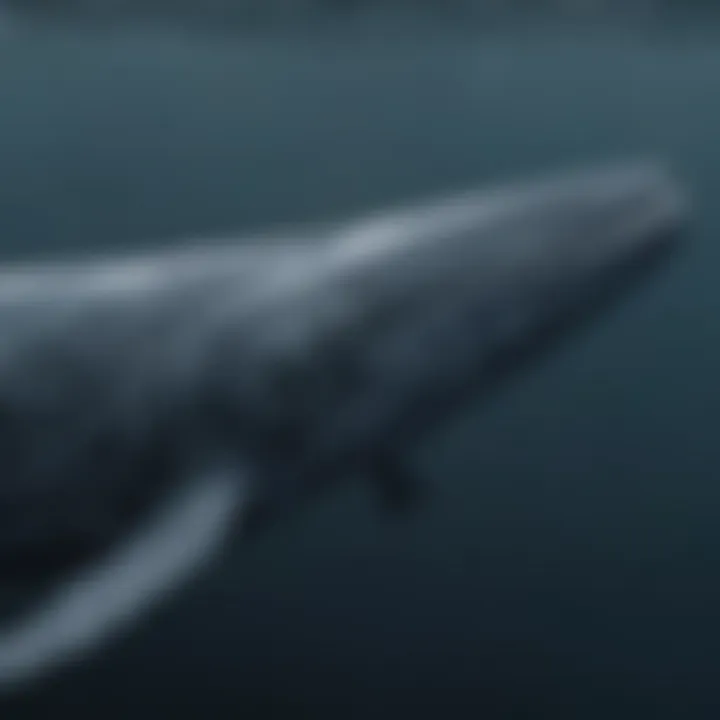
Intro
The blue whale is an awe-inspiring creature. This marine mammal not only holds the title of the largest animal to ever exist but also plays a vital role in the ocean ecosystem. Understanding the blue whale requires examining its biological characteristics, ecological significance, evolutionary history, and current conservation challenges. This exploration aims to shed light on the blue whale’s impact on the environment and the necessity of ongoing research efforts to ensure its survival.
History and Origins
The blue whale's history stretches back millions of years. It belongs to the Balaenoptera genus, which is a group of fin whales. Historically, these majestic animals were found in every ocean across the globe. Their size, reaching up to 100 feet long and weighing as much as 200 tons, positions them at the top of the marine food chain.
Overview of Biological Characteristics
Blue whales possess distinct physical features that make them unique. Their elongated bodies are characterized by a bluish-grey color, mottled with lighter spots. The dorsal fin is relatively small, and their pleated throat helps to accommodate large quantities of water when feeding. Blue whales primarily consume krill, filtering these tiny shrimp-like creatures through their baleen plates.
Historical Significance and Cultural Impact
Throughout history, blue whales have captured human fascination. They appear in various cultural narratives and have been subjects of scientific study for centuries. In some maritime cultures, blue whales symbolize the majesty of the sea, reflecting humanity's respect and awe for nature. Their sheer size makes them remarkable and often leads to conservation efforts being inspired by their plight.
"The blue whale is not just an animal; it is a symbol of the fragility of our oceans and the challenges they face."
Identification and Classification
Identifying blue whales is relatively straightforward due to their impressive size and unique features. However, distinguishing them from other large whales can pose a challenge.
Guide to Identifying Characteristics
- Coloration: Blue whales typically showcase a bluish tint with lighter spots. This can appear duller in certain conditions.
- Size: Adults can reach incredible lengths of approximately 100 feet.
- Blow: They produce a tall, vertical spout when they surface, often seen from afar.
- Fluke Shape: The tail fluke of a blue whale is wide and triangular.
Common Types and Variations
While the blue whale itself is a distinct species, there are subspecies based on regions. For example, the northern blue whale and the southern blue whale display slight variations in size and behavior. Understanding these differences is crucial for conservation efforts.
As the research continues, the blue whale remains a focal point for studies concerning marine biology and ocean conservation. Their status reflects the health of ocean ecosystems as a whole, demanding our understanding and preservation efforts.
Intro to the Blue Whale
The blue whale is not just an animal; it is an apex of biological achievement, embodying the extremes of size and adaptation known to science. This introduction serves to establish the significance of understanding the blue whale within the broader context of marine biology and ecology. By examining this extraordinary creature, readers can gain insight into the complex interrelationships that shape marine environments.
Significance of the Blue Whale
The blue whale holds critical ecological roles. It influences marine food webs and supports various species within its habitat. As the largest animal on Earth, it symbolizes the peak of evolutionary processes and embodies the wonders of the ocean. Its presence or absence in marine ecosystems can indicate the health of oceanic environments.
Conserving the blue whale is paramount. This not only protects the species but also preserves the vast ecosystems it inhabits. Understanding its biology and behavior is essential for informing conservation strategies and policies. Every facet of the blue whale, from its migratory patterns to its feeding habits, offers valuable data points on the state of our oceans.
Purpose of the Article
The primary aim of this article is to furnish a comprehensive exploration of the blue whale. This involves delving into its biological characteristics, ecological role, and evolutionary history. Additionally, it addresses current conservation challenges and ongoing research regarding the species.
By synthesizing present knowledge and ongoing initiatives, the article aspires to enlighten readers about the intricacies of the blue whale's life and the implications for marine conservation. Understanding the complexities surrounding this magnificent creature helps foster deeper appreciation and awareness among those concerned with ecological integrity. In doing so, it encourages action towards safeguarding marine biodiversity for future generations.
Biological Characteristics
The biological characteristics of the blue whale provide crucial insight into its adaptation to life in the oceans. Understanding these traits not only enhances our knowledge of the species but also contributes to conservation efforts. The blue whale's unique physical and physiological features are significant for recognizing its role in the marine ecosystem and its evolutionary history.
Physical Dimensions
Length and Weight
The blue whale is known for its enormous size, reaching lengths up to 100 feet and weighing as much as 200 tons. This aspect of length and weight is not only fascinating but it is also essential for several reasons. Firstly, large size allows blue whales to have fewer natural predators. This higher body mass also aids in energy storage, providing them with reserves during times of scarce food. However, this size can be a double-edged sword, as it requires an immense intake of food, influencing their migratory patterns and feeding strategies.
Additionally, their sheer length enables them to traverse vast distances in search of krill, forming a fundamental part of their feeding habits.
Size Comparison with Other Animals
When comparing the blue whale to other animals, it is astonishing to note that it holds the title as the largest known animal to have ever existed, even dwarfing the dinosaurs. This comparison highlights not just the enormity of these creatures but also illustrates the unique ecological niche they occupy. The size difference becomes profound when juxtaposed against other marine animals, such as great white sharks and even other large whales like the sperm whale. Their dominating size ensures that blue whales are top-tier mammals in their environment, which plays a key role in shaping marine biodiversity and ecosystem dynamics.


Anatomy and Physiology
Adaptations for Marine Life
The blue whale has specific adaptations that enable its survival in the oceanic environment. The streamlined body shape reduces water resistance, allowing them to swim efficiently. Its large, fluked tail propels it through the water while their baleen plates filter food from the water when feeding. These features make the blue whale a highly efficient swimmer. Their adaptations are critical for maintaining their body temperature in cold waters and securing access to food while preserving energy.
However, these adaptations can limit their movement to specific habitats where water conditions allow for their survival and breeding.
Respiratory and Circulatory Systems
The blue whale possesses remarkable respiratory and circulatory systems that are distinct among marine mammals. Their lung capacity can reach up to 2,000 liters, enabling them to hold their breath for around 30 minutes while diving. This efficiency in gas exchange supports their physical activity during deep foraging. Additionally, their circulatory system is adapted to transport large volumes of oxygen, crucial for sustaining their size during dives.
On the downside, this system may make them vulnerable to rapid changes in environmental conditions, such as pollution or climate change, affecting the health of their populations.
Feeding Habits and Diet
Methods of Feeding
Blue whales utilize a unique feeding method known as lunge feeding. They accelerate towards swarms of krill, open their mouths wide, and gulp a large volume of water mixed with the prey. This method is efficient, allowing ingestion of thousands of krill per mouthful. Consequently, this feeding strategy enables them to meet their extensive dietary needs.
Nonetheless, the efficiency of this method can be impacted by decreases in krill populations due to environmental shifts or overfishing.
Krill and Nutritional Needs
Krill serves as the primary food source for blue whales, highlighting their role as a critical component of marine food webs. The nutritional needs are vast; a single adult blue whale can consume around 4 tons of krill each day during feeding seasons. This dependence on krill accentuates how climate change and ocean warming can directly impact the blue whale's survival and overall health. Their large appetite and specific diet underscore the challenges they face in a rapidly changing environment, solidifying the need for continued conservation efforts.
Ecological Role
The ecological role of the blue whale is vital to understanding its impact on marine life and habitat dynamics. This section delves into two major aspects: habitat and distribution, and the impact on marine ecosystems. Each piece plays a part in how blue whales contribute to the oceanic environment, linking their survival to the overall health of marine ecosystems.
Habitat and Distribution
Global Presence
The global presence of the blue whale spans across all oceans, from the Arctic to the Antarctic. This wide distribution is an essential aspect of their biology and contributes a great deal to marine biodiversity. Blue whales are mainly found in deep waters, preferring areas with rich feeding grounds. The diversity of ecosystems they inhabit supports varied marine life, reinforcing the interconnectedness of ocean life.
These habitats are characterized by open ocean waters, which provide ample space for these large creatures to navigate. The vast reach of blue whales makes them a beneficial species in marine environments, as they often migrate long distances indicative of healthy ocean ecosystems. However, this global distribution also poses challenges; it exposes them to international threats, such as shipping traffic and varying governmental regulations that may affect their protections.
Preferred Habitats
Blue whales favor certain habitats that are nutrient-rich. These locations are typically found near upwelling zones, where cold, nutrient-laden waters rise to the surface. These habitats not only provide food but also enhance reproductive success, as the abundance of krill in these areas is critical for their diet.
The unique feature of these preferred habitats is their dynamic nature. Seasonal changes can lead to shifts in krill populations, forcing blue whales to adapt their migratory patterns. This adaptability can be an advantage, but it also means that their survival is closely linked to environmental changes, raising concerns under scenarios of climate change and overfishing that may deplete their food resources.
Impact on Marine Ecosystems
Trophic Levels
Blue whales play a significant role in trophic dynamics within marine ecosystems. As filter feeders, they primarily consume krill, which places them at the top of the food chain. By controlling krill populations, blue whales help maintain a balanced marine food web. Their feeding habits influence not only the species they eat but also the predator-prey relationships that develop through these dynamics.
The importance of understanding trophic levels related to blue whales supports the idea of conserving marine ecosystems. Their role as key species reinforces the notion that protecting blue whales can have cascading effects on ocean health, benefiting other marine life and maintaining biodiversity.
Biodiversity Effects
The interaction of blue whales within their ecosystems promotes biodiversity. Their feeding activities contribute to nutrient cycling, which aids a variety of marine life at different levels of the food web. The presence of blue whales often indicates a healthy ecosystem, capable of supporting a diverse range of species.
Conversely, declining whale populations can signify deteriorating ocean health. The emphasis on their biodiversity effects raises awareness for conservation efforts. By protecting blue whales, one also supports the myriad of life forms that rely on a balanced and rich marine environment.
The conservation of the blue whale is not just about one species; it is about preserving the intricate web of life that exists within our oceans.
Evolutionary Perspective
The evolutionary perspective offers a crucial lens through which to understand the complexity and development of the blue whale. By examining the phylogenetic relationships and fossil records, researchers can trace the lineage of these majestic creatures and draw important conclusions about their adaptations and survival. This section delves into the ancestry of modern whales, their significant evolutionary adaptations, and the discoveries that illuminate their past.
Phylogenetic Relationships
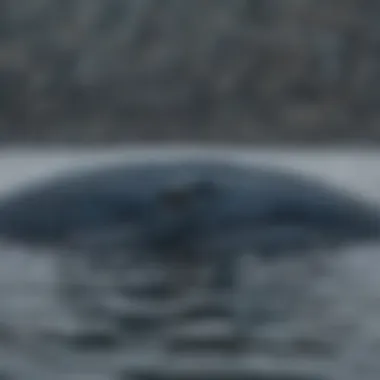
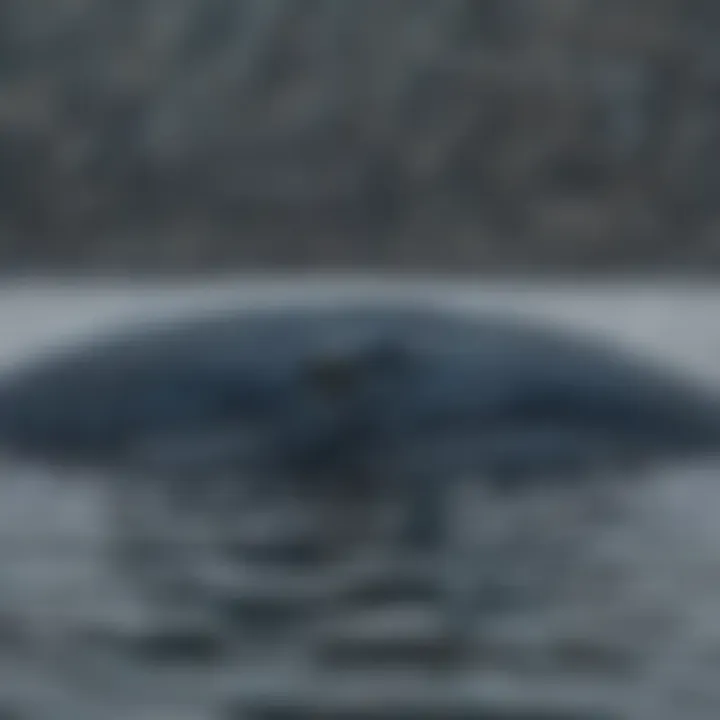
Ancestry of Modern Whales
The ancestry of modern whales is a fascinating component of evolutionary biology. Current studies suggest that whales descended from land-dwelling mammals. This is a pivotal notion as it showcases the dramatic transitions that these species have undergone. One key characteristic of this ancestry is the morphological changes that adapted whales for life in water.
The unique skeletal features of these ancestral species, like the reduction of hind limbs, provide insights into their gradual adaptation to a marine environment. This understanding of ancestry offers compelling evidence of how evolutionary pressures can shape a species to thrive in a different habitat.
Evolutionary Adaptations
Evolutionary adaptations have played a significant role in how blue whales survive today. One of the most notable adaptations is their size, which may help them avoid predators and efficiently travel in their aquatic environment. Another vital adaptation is their complex communication system, which enables them to locate each other across vast distances.
The prototype of blubber as an insulator is another advantageous feature to withstand varying ocean temperatures. These adaptations are beneficial for sustaining their existence in changing environments. They offer essential insights into the resilience of a species arising from deep evolutionary roots.
Fossil Record
Significant Discoveries
The fossil record serves as a cornerstone in understanding blue whale evolution. The discovery of ancient fossils has significantly enhanced the understanding of whale evolution, particularly the identification of transitional forms that connect ancient terrestrial mammals to modern cetaceans. These significant finds highlight the diverse adaptations that occurred during this evolutionary journey.
For example, the fossils of Basilosaurus present a critical link, showcasing the transitional features from land to water. These discoveries provide compelling evidence on the timeline of evolutionary changes and underscore the importance of continuous study in paleontology.
Implications for Understanding Evolution
The implications of studying the fossil record are profound. Understanding the evolution of blue whales has broader implications for comprehending global biodiversity and evolutionary mechanisms. The key takeaway here is that each fossil unearthed offers a snapshot of a moment in evolutionary history.
These unique features linked to the fossil record help map the ecological shifts and pressures of past environments that have shaped the genetic makeup of current marine giants. This understanding is significant for scientists and conservationists alike, as it assists in predicting future adaptations in a changing world.
The study of evolutionary perspectives regarding the blue whale not only enriches our comprehension of this majestic creature but also stresses the importance of safeguarding their continued existence in our oceans.
Conservation and Threats
The blue whale, as the largest creature on Earth, faces various challenges that threaten its very existence. Understanding the conservation status and the threats it faces is critical for both earnest enthusiasts and the general public. This section explores these essential elements, providing insight into how they interplay with the survival of this magnificent species.
Current Conservation Status
Population Estimates
Population estimates for blue whales provide crucial data on their current survival status. The estimates suggest that around 10,000 to 25,000 blue whales exist in the world today. This range indicates a slow recovery from historical whaling practices that led to drastic declines. The importance of these numbers lies in recognizing trends in population growth or decline.
The most significant characteristic of these estimates is their reflection of long-term recovery efforts. This data fuels conservation initiatives and encourages ongoing research. However, these estimates carry limitations due to varying methodologies used in population assessments and the challenges of tracking these vast animals in their expansive ocean habitats.
Legal Protections
Legal protections play a vital role in ensuring the survival of the blue whale. Various international treaties and laws aim to prevent further hunting and trade of blue whale products. Notably, the Marine Mammal Protection Act and the Endangered Species Act in the United States provide frameworks to safeguard this species.
The key feature of these protections is their ability to create sanctuaries and limit human interaction. By enforcing hunting bans and habitat protections, these laws enhance the chances of recovery. However, limitations still exist in enforcement and international cooperation. The complexity of global conservation adds layers to how effectively these protections translate into tangible outcomes for blue whale populations.
Threats to Survival
Climate Change
Climate change is a major threat to blue whales, impacting their habitat and food sources. Changes in ocean temperature alter krill populations, the primary food source for blue whales. As the ocean warms, krill may migrate to cooler waters, leading to potential food scarcity for these giants.
The distinctive aspect of climate change is its pervasive nature, affecting multiple ecosystems simultaneously. This interconnectivity means that the consequences of climate change extend beyond blue whales to whole marine environments. However, addressing such a complex issue requires substantial global collaboration, which often proves difficult.
Human Activities
Human activities present significant risks to the blue whale's survival. From ship strikes to noise pollution, these threats disrupt their natural behaviors. Ship traffic, particularly in busy shipping lanes, poses physical danger through collisions. Furthermore, underwater noise affects blue whale communication and navigation.
The prominent feature of these activities is their direct link to human industries. As commercial shipping continues to grow, so do the odds of human-wildlife conflicts. While regulations exist to mitigate these threats, the effectiveness of these measures often varies by region and enforcement capabilities, making it a challenging area for conservationists.
Understanding the conservation status and threats faced by blue whales is crucial. It informs broader discussions on marine conservation and highlights the interconnectedness of human activities and wildlife survival.
Research and Discoveries
Research on the blue whale is crucial for understanding both the species itself and the broader marine ecosystem. This section examines key research initiatives and future directions in the study of this magnificent creature. The ongoing discoveries shape our understanding of whales and have significant implications for conservation efforts.
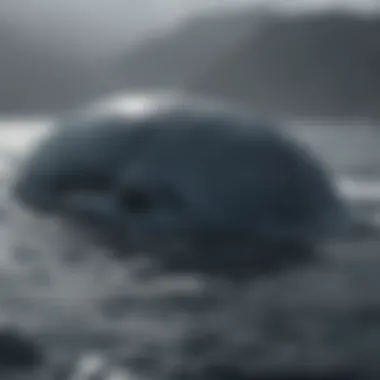
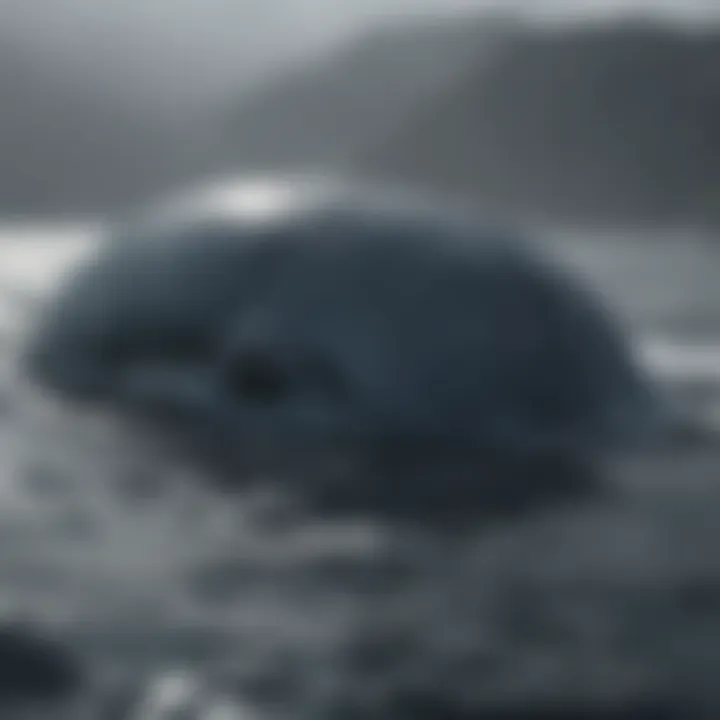
Current Research Initiatives
Tagging and Tracking
Tagging and tracking blue whales offer a unique view into their behavior and migration patterns. Equipped with satellite tags, researchers can monitor the whales' movements in real-time. This type of research is essential for understanding their feeding habits and migration routes. Blue whales often traverse vast distances, and knowing their paths can aid in protecting critical habitats.
One notable characteristic of tagging is that it allows scientists to gather data over extended periods, which is helpful in assessing the impact of environmental changes. However, this method does come with its disadvantages. Some tags can distress the whales during the application process, raising ethical questions. Despite this, tagging remains a popular choice in marine research due to the valuable insights it provides.
Marine Biology Studies
Marine biology studies focus on the broader context in which blue whales exist. Researchers investigate various marine ecosystems and how they interact with whale populations. This research provides invaluable data on the health of marine environments, highlighting the importance of krill and other prey species for blue whale survival.
A key feature of these studies is the integration of ecological data with the behaviors of blue whales. Such a comprehensive approach enhances understanding of how these animals impact their surroundings. However, the complexity of marine ecosystems can present challenges in drawing definitive conclusions. Still, the benefits of these studies contribute significantly to marine conservation and management strategies.
Future Research Directions
Climate Change Adaptation
The impacts of climate change on blue whales are an important area for future research. Understanding how these animals adapt to changing oceanic conditions is vital for their preservation. As temperatures rise and feeding grounds shift, the blue whale's ability to adapt will determine its future survival.
A major characteristic of climate change adaptation research is its multidisciplinary approach, combining marine biology, climatology, and conservation science. This makes it a critically valuable avenue of investigation. The unique feature here is the real-time data collection through various platforms, allowing researchers to assess the ongoing changes quickly. However, this line of inquiry requires significant resources and collaboration, which can be challenging.
Human Interaction Studies
Human interaction studies focus on how human activities affect blue whale populations. This includes shipping traffic, fishing nets, and ocean pollution. Ongoing research in this area is crucial for creating effective conservation policies. Understanding these interactions helps to formulate strategies that mitigate negative impacts on whale populations.
The key characteristic of this type of research is its immediate application in policy. By gaining insight into the threats posed by humans, the studies can guide legislative measures. The unique aspect involves community engagement, ensuring that local populations are also part of conservation efforts. Nonetheless, tracking human impacts can be complex, often requiring multidisciplinary approaches that involve various stakeholders.
Cultural Significance
The blue whale holds a prominent place not only in the natural world but also in human culture. Its massive size and unique characteristics have inspired numerous discussions in conservation, art, and literature. Understanding its role in our culture offers insights into how humanity perceives the oceans and the beings that inhabit them.
Symbolism in Marine Conservation
The blue whale has become a powerful symbol in the fight for marine conservation. It represents the fragility of ocean ecosystems, used often to illustrate the impacts of climate change and pollution. Its existence highlights the importance of marine life and the challenges they face.
For example, organizations often use the image of the blue whale in campaigns aimed at raising awareness for marine sanctuaries. This symbol resonates widely, inspiring individuals to consider their effect on the environment. It evokes compassion and calls for action. The whale emphasizes that large mammals like itself are not exempt from environmental threats. Moreover, this symbolic association has helped galvanize community efforts around initiatives like beach cleanups and no-plastic campaigns.
Impact on Art and Literature
The blue whale also significantly influences art and literature. Artists often depict these majestic creatures in various forms, exploring themes of immensity, isolation, and wonder. Literature about the blue whale frequently delves into the ocean's mysteries, using the whale as a metaphor for deeper philosophical discussions.
Many writers have featured the blue whale in fiction and poetry, often attributing human emotions and characteristics to it. The whale's vastness serves as a narrative backdrop for stories about exploration and the unknown.
- Notable works include:
- "Moby-Dick" by Herman Melville, where the creature represents man's struggle against the vastness of nature.
- Various contemporary poems that reflect on the whale's grace amidst the chaos of life.
The blue whale, in both art and literature, reflects our society’s ongoing relationship with nature, illustrating both our fascination and responsibility toward these magnificent beings.
In summary, the cultural significance of the blue whale stretches far beyond its biological attributes. It has become a symbol for marine protection and inspires creative pursuits across multiple disciplines. Understanding this aspect enhances our appreciation for the species itself and raises awareness about the urgency of its conservation.
Culmination
The conclusion serves as the essential bridge that synthesizes the various elements discussed throughout the article on the blue whale. This summarization is critical not only for reinforcing the comprehensive nature of the data presented but also for highlighting the intricate connections between the blue whale's biology, ecology, and its significance in the greater context of marine life and conservation efforts.
Summary of Key Points
In our exploration, we have uncovered numerous fascinating aspects regarding the blue whale. Key points include:
- Biological Characteristics: Understanding the blue whale's remarkable size and adaptations is vital for appreciating its role in marine ecosystems. Its unique physiology enables it to thrive in oceanic environments where it can reach lengths of up to 100 feet and weights exceeding 200 tons.
- Ecological Role: The blue whale has a profound influence on marine ecosystems as it participates in the nutrient cycle through its feeding habits on krill and interactions within its habitat.
- Evolutionary Perspective: The evolution of the blue whale reveals its significant link to terrestrial mammals, illustrating the profound changes that have occurred over millions of years to adapt to aquatic life.
- Conservation and Threats: The blue whale faces numerous threats, primarily from human activities and climate change, underscoring the need for conservation efforts and awareness.
This summary emphasizes the interconnectedness of the various themes and encourages a deeper reflection on how these elements contribute to our understanding and appreciation of this magnificent creature.
Call to Action for Conservation Efforts
Given the various threats faced by blue whales, it is imperative that individuals and communities engage in conservation efforts. Strategies include:
- Supporting Marine Protected Areas: By advocating for the establishment and enforcement of marine sanctuaries, the habitats critical to the blue whale's survival can receive the protection they deserve.
- Participating in Awareness Campaigns: Educating others about the challenges that blue whales face can foster a collective effort towards their conservation.
- Contributing to Research Initiatives: Engaging with organizations that focus on marine research can provide valuable data that informs conservation policies and practices.
Ultimately, the fate of the blue whale is intertwined with human actions. By prioritizing sustainable practices, we can contribute significantly toward ensuring that future generations will continue to admire and study the largest animal to ever live on our planet.

